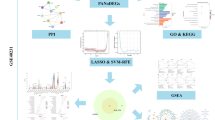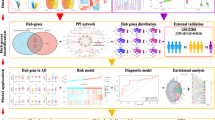Abstract
Multiple profiling studies have identified a number of non-coding RNAs associated with the pathogenesis of human diseases. However, the exact regulatory mechanisms and functions of these non-coding RNAs in the development of osteoporosis have not yet been explored. Transcriptome gene expression and miRNA microarray data from peripheral blood monocytes of five high hip bone mineral density (BMD) subjects and five low hip BMD subjects were analyzed. Differentially expressed mRNAs, lncRNAs, and miRNAs were identified and subjected to functional enrichment analysis. Additionally, protein–protein interaction (PPI), lncRNA–mRNA, and mRNA–lncRNA–miRNA competing endogenous RNA (ceRNA) networks were constructed. Differential analysis revealed that 297 mRNAs, 151 lncRNAs, and 38 miRNAs were significantly differentially expressed between peripheral blood monocytes from high and low hip BMD subjects. Key genes including ACLY, HSPA5, and AKT1 were subsequently identified in the PPI network. Additionally, differentially expressed lncRNAs were primarily enriched in the citrate cycle (TCA cycle), biosynthesis of antibiotics, and carbon metabolism pathways. Finally, the mRNA–lncRNA–miRNA network revealed several key ceRNA regulatory relationships among the transcripts and non-coding RNAs. Key mRNAs and non-coding RNAs identified in the networks represent potential biomarkers or targets in the diagnosis and management of osteoporosis. Our findings represent a resource for further functional research on the ceRNA regulation mechanism of non-coding RNA in osteoporosis.






Similar content being viewed by others
Data Availability
The datasets analyzed in the present study are available from the Gene Expression Omnibus repository, https://www.ncbi.nlm.nih.gov/geo/query/acc.cgi?acc=GSE35959.
References
Lane NE (2006) Epidemiology, etiology, and diagnosis of osteoporosis. Am J Obstet Gynecol 194:S3–11
Ensrud KE, Crandall CJ (2017) Osteoporosis. Ann Intern Med 167:Itc17-itc32
Bijelic R, Milicevic S, Balaban J (2017) Risk factors for osteoporosis in postmenopausal women. Med Arch (Sarajevo, Bosnia and Herzegovina) 71:25–28
You L, Pan L, Chen L, Gu W, Chen J (2016) MiR-27a is essential for the shift from osteogenic differentiation to adipogenic differentiation of mesenchymal stem cells in postmenopausal osteoporosis. Cell Physiol Biochem 39:253–265
McCormick RK (2007) Osteoporosis: integrating biomarkers and other diagnostic correlates into the management of bone fragility. Altern Med Rev 12:113–145
Eastell R, Szulc P (2017) Use of bone turnover markers in postmenopausal osteoporosis. Lancet Diabetes Endocrinol 5:908–923
Szulc P, Naylor K, Hoyle NR, Eastell R, Leary ET (2017) Use of CTX-I and PINP as bone turnover markers: National Bone Health Alliance recommendations to standardize sample handling and patient preparation to reduce pre-analytical variability. Osteopor Int 28:2541–2556
Dou C, Cao Z, Yang B et al (2016) Changing expression profiles of lncRNAs, mRNAs, circRNAs and miRNAs during osteoclastogenesis. Sci Rep 6:21499
Takao N, Tetsuro H (2013) Paraspeckle formation during the biogenesis of long non-coding RNAs. RNA Biol 10:456–461
Mei B, Wang Y, Ye W, Huang H, Zhou Q, Chen Y, Niu Y, Zhang M, Huang Q (2019) LncRNA ZBTB40-IT1 modulated by osteoporosis GWAS risk SNPs suppresses osteogenesis. Hum Genet 138(2):151–166
Li W, Zhu H, Xu H, Zhang B, Huang S (2018) CRNDE impacts the proliferation of osteoclast by estrogen deficiency in postmenopausal osteoporosis. Eur Rev Med Pharmacol Sci 22:5815–5821
Guan B-G, Cai X-X (2019) Abnormal sub-pathways competitively regulated by lncRNAs contribute to postmenopausal osteoporosis. Exp Ther Med 17:2894–2900
Jing Q, Huang S, Guth S, Zarubin T, Motoyama A, Chen J, Di Padova F, Lin SC, Gram H, Han J (2005) Involvement of microRNA in AU-rich element-mediated mRNA stability. Cell 120:623–634
Cui Q, Xing J, Yu M, Wang Y, Xu J, Gu Y, Nan X, Ma W, Liu H, Zhao H (2019) Mmu-miR-185 depletion promotes osteogenic differentiation and suppresses bone loss in osteoporosis through the Bgn-mediated BMP/Smad pathway. Cell Death Dis 10:172
Lu X-D, Han W-X, Liu Y-X (2019) Suppression of miR-451a accelerates osteogenic differentiation and inhibits bone loss via Bmp6 signaling during osteoporosis. Biomed Pharmacother 120:109378
Gu H, Wu L, Chen H, Huang Z, Xu J, Zhou K, Zhang Y, Chen J, Xia J, Yin X (2019) Identification of differentially expressed microRNAs in the bone marrow of osteoporosis patients. Am J Transl Res 11:2940
Shao M (2017) Construction of an miRNA-regulated pathway network reveals candidate biomarkers for postmenopausal osteoporosis. Comput Math Methods Med 2017:9426280
Wang J-D, Zhou H-S, Tu X-X, He Y, Liu Q-F, Liu Q, Long Z-J (2019) Prediction of competing endogenous RNA coexpression network as prognostic markers in AML. Aging (Albany, NY) 11:3333
Wang C-G, Liao Z, Xiao H, Liu H, Hu Y-H, Liao Q-D, Zhong D (2019) LncRNA KCNQ1OT1 promoted BMP2 expression to regulate osteogenic differentiation by sponging miRNA-214. Exp Mol Pathol 107:77–84
Yang L, Li Y, Gong R, Gao M, Feng C, Liu T, Sun Y, Jin M, Wang D, Yuan Y (2019) The long non-coding RNA-ORLNC1 regulates bone mass by directing mesenchymal stem cell fate. Mol Ther 27:394–410
Zhang JG, Tan LJ, Xu C, He H, Tian Q, Zhou Y, Qiu C, Chen XD, Deng HW (2015) Integrative analysis of transcriptomic and epigenomic data to reveal regulation patterns for BMD variation. PLoS ONE 10:e0138524
Wright GW, Simon RM (2003) A random variance model for detection of differential gene expression in small microarray experiments. Bioinformatics 19:2448–2455
Yang H, Crawford N, Lukes L, Finney R, Lancaster M, Hunter KW (2005) Metastasis predictive signature profiles pre-exist in normal tissues. Clin Exp Metastasis 22:593–603
Misha K, Patrick K, Culhane AC, Steffen D, Jan I, Christine KR, Meelis K, Aurora T, Ugis S, Jaak V (2004) Expression Profiler: next generation—an online platform for analysis of microarray data. Nucleic Acids Res 32:465–470
Gene Ontology C (2006) The Gene Ontology (GO) project in 2006. Nucleic Acids Res 34:D322–326
Kanehisa M, Goto S, Kawashima S, Okuno Y, Hattori M (2004) The KEGG resource for deciphering the genome. Nucleic Acids Res 32:D277–280
Simson L, Mcalpine CH (1998) Awareness of osteoporosis risk factors and use of treatment. Age Ageing 27:17–17
Liu HY, Wu AT, Tsai CY, Chou KR, Zeng R, Wang MF, Chang WC, Hwang SM, Su CH, Deng WP (2011) The balance between adipogenesis and osteogenesis in bone regeneration by platelet-rich plasma for age-related osteoporosis. Biomaterials 32:6773–6780
Lau EMC, Suriwongpaisal P, Lee JK, De SD, Festin MR, Saw SM, Khir A, Torralba T, Sham A, Sambrook P (2010) Risk factors for hip fracture in Asian men and women: The Asian Osteoporosis Study. J Bone Miner Res 16:572–580
Zhou Y, Xu C, Zhu W, He H, Zhang L, Tang B, Zeng Y, Tian Q, Deng HW (2019) Long noncoding RNA analyses for osteoporosis risk in Caucasian women. Calcif Tissue Int 105:183–192
Bidwell JP, Alvarez MB, Hood M, Childress P (2013) Functional impairment of bone formation in the pathogenesis of osteoporosis: the bone marrow regenerative competence. Curr Osteoporos Rep 11:117–125
Li C, Xiao Y, Yang M, Su T, Sun X, Guo Q, Huang Y, Luo XH (2018) Long noncoding RNA Bmncr regulates mesenchymal stem cell fate during skeletal aging. J Clin Investig 128:5251–5266
Liang WC, Fu WM, Wang YB, Sun YX, Xu LL, Wong CW, Chan KM, Li G, Waye MY, Zhang JF (2016) H19 activates Wnt signaling and promotes osteoblast differentiation by functioning as a competing endogenous RNA. Sci Rep 6:20121
Li B, Zhao J, Ma JX, Li GM, Zhang Y, Xing GS, Liu J, Ma XL (2018) Overexpression of DNMT1 leads to hypermethylation of H19 promoter and inhibition of Erk signaling pathway in disuse osteoporosis. Bone 111:82–91
Wang Y, Luo TB, Liu L, Cui ZQ (2018) LncRNA LINC00311 promotes the proliferation and differentiation of osteoclasts in osteoporotic rats through the notch signaling pathway by targeting DLL3. Cell Physiol Biochem 47:2291
Bazilevsky GA, Affronti HC, Wei X, Campbell SL, Wellen KE, Marmorstein R (2019) ATP-citrate lyase multimerization is required for coenzyme-A substrate binding and catalysis. J Biol Chem 294:7259–7268
Teng L, Chen Y, Cao Y, Wang W, Xu Y, Wang Y, Lv J, Li C, Su Y (2018) Overexpression of ATP citrate lyase in renal cell carcinoma tissues and its effect on the human renal carcinoma cellsin vitro. Oncol Lett 15:6967–6974
Nicodemus KK, Folsom AR (2001) Type 1 and Type 2 diabetes and incident hip fractures in postmenopausal women. Diabetes Care 24:1192–1197
Petit MA, Paudel ML, Taylor BC, Hughes JM, Strotmeyer ES, Schwartz AV, Cauley JA, Zmuda JM, Hoffman AR, Ensrud KE (2010) Bone mass and strength in older men with type 2 diabetes: the osteoporotic fractures in Men Study. J Bone Miner Res 25:285–291
Wongdee K, Charoenphandhu N (2011) Osteoporosis in diabetes mellitus: possible cellular and molecular mechanisms. World J Diabetes 2:41–48
Shi W, Xu G, Wang C, Sperber SM, Chen Y, Zhou Q, Deng Y, Zhao H (2015) Heat shock 70-kDa protein 5 (Hspa5) is essential for pronephros formation by mediating retinoic acid signaling. J Biol Chem 290:577–589
Guzel E, Basar M, Ocak N, Arici A, Kayisli UA (2011) Bidirectional interaction between unfolded-protein-response key protein HSPA5 and estrogen signaling in human endometrium. Biol Reprod 85:121–127
Chang YW, Tseng CF, Wang MY, Chang WC, Lee CC, Chen LT, Hung MC, Su JL (2016) Deacetylation of HSPA5 by HDAC6 leads to GP78-mediated HSPA5 ubiquitination at K447 and suppresses metastasis of breast cancer. Oncogene 35:1517–1528
Chen H, Xing J, Hu X, Chen L, Lv H, Xu C, Hong D, Wu X (2017) Inhibition of heat shock protein 90 rescues glucocorticoid-induced bone loss through enhancing bone formation. J Steroid Biochem Mol Biol 171:236
Daswani B, Gavali S, Desai M, Patil A, Khatkhatay M (2016) Serum levels of phosphorylated heat shock protein 27 (pHSP27) are associated with bone mineral density in pre- & postmenopausal women: a pilot study. Indian J Med Res 143:288–296
Rong PZ, Si JL, Wen BW, Hui LZ, Yao FF, Hui BR, Jin X, Wei S, Yi CZ, Shi YW (2016) Chlorogenic acid prevents osteoporosis by Shp2/PI3K/Akt pathway in ovariectomized rats. PLoS ONE 11:e0166751
Mcmanus S, Bisson M, Chamberland R, Roy M, Nazari S, Roux S (2016) Autophagy and 3-phosphoinositide-dependent kinase 1 (PDK1)-related kinome in pagetic osteoclasts. J Bone Miner Res 31:1334–1343
Kawamura N, Kugimiya F, Oshima Y, Ohba S, Ikeda T, Saito T, Shinoda Y, Kawasaki Y, Ogata N, Hoshi K (2007) Akt1 in osteoblasts and osteoclasts controls bone remodeling. PLoS ONE 2(10):e1058
Aditi M, Wilson EM, Peter R (2010) Selective signaling by Akt2 promotes bone morphogenetic protein 2-mediated osteoblast differentiation. Mol Cell Biol 30:1018–1027
Acknowledgements
We thank Mr. Donglin Cheng for his technical assistance.
Funding
This study is supported by the Fundamental Research Funds for the Central Universities (Grant No. WK9110000093) and National Natural Science Foundation of China (Grant No. 81902201).
Author information
Authors and Affiliations
Contributions
XFS conceived the idea and designed the project. NK performed the data analysis. XZZ and ZDW wrote the paper. HYL and GYL revised the manuscript. All authors have read and approved the manuscript.
Corresponding authors
Ethics declarations
Conflict of interest
Xianzuo Zhang, Haiyi Liang, Nikolaos Kourkoumelis, Zhaodong Wu, and Guoyuan Li and Xifu Shang declare that they have no conflict of interest.
Human and Animal Rights
The study was conducted in accordance with the 1964 Declaration of Helsinki and its later amendments. The study protocol has been approved by the Institutional Review Boards of The First Affiliated Hospital of USTC (University of Science and Technology of China).
Informed Consent
Not applicable.
Additional information
Publisher's Note
Springer Nature remains neutral with regard to jurisdictional claims in published maps and institutional affiliations.
Electronic supplementary material
Below is the link to the electronic supplementary material.
223_2019_643_MOESM1_ESM.jpg
Supplementary Figure 1 The mRNA-lncRNA-miRNA pathway network. Green circular nodes represent mRNAs, green triangular nodes represent lncRNAs, red rectangular nodes represent miRNAs, and grey arrows represent pathways. Supplementary file1 (JPG 509 kb)
Rights and permissions
About this article
Cite this article
Zhang, X., Liang, H., Kourkoumelis, N. et al. Comprehensive Analysis of lncRNA and miRNA Expression Profiles and ceRNA Network Construction in Osteoporosis. Calcif Tissue Int 106, 343–354 (2020). https://doi.org/10.1007/s00223-019-00643-9
Received:
Accepted:
Published:
Issue Date:
DOI: https://doi.org/10.1007/s00223-019-00643-9




